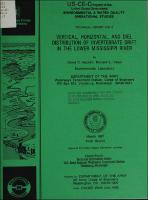Please use this identifier to cite or link to this item:
https://hdl.handle.net/11681/4499| Title: | Vertical, horizontal, and diel distribution of invertebrate drift in the lower Mississippi River |
| Authors: | Environmental and Water Quality Operational Studies (U.S.) Beckett, David C. Kasul, Richard L. (Richard Lawrence) |
| Keywords: | Freshwater invertebrates Invertebrate populations Mississippi River Biology Ecology Water quality |
| Publisher: | Environmental Laboratory (U.S.) Engineer Research and Development Center (U.S.) |
| Description: | Technical Report Abstract: Lower Mississippi River macroinvertebrate drift densities and composition were determined at 3-hr intervals over 24- hr periods in mid-May and early June 1982. Samples were taken at the surface, middepth, and near the bottom at a nearshore sampling station and at the surface and middepth at a sampling station near the navigation channel. The overall mean drift density equaled 35.0 invertebrates/100 m³ of water. Overall, Chaoborus larvae were the most common invertebrates collected, followed, respectively, by chironomid pupae, Hydra sp., Hydropsyche orris, and Hexagenia sp. Chaoborus larvae did not exhibit increased drift nocturnally, but did show significantly higher densities at the nearshore station. Hexagenia was significantly more abundant both at the nearshore station and in the nighttime sampling. Hydropsyche orris, Hexagenia, and chironomid pupae were not uniformly distributed at the river's various depths, being present in greater densities in the middepth and/or bottom samples than at the surface. It is apparent that the use of only surface nets could seriously underestimate the actual drift densities of these taxa. A number of unusual mayfly taxa were collected, including Spinadis wallacei, Pseudiron sp., and Anepeorus sp. A diverse assemblage of naidid worms was also present in the drift, with Slavina appendiculata, Nais communis, and Wapsa mobilis, respectively, being present in the largest numbers. The abundances of various taxa in the Lower Mississippi River's drift seem to change markedly on a site-to-site basis, as a function of the physical characteristics of the river and its substrates in a certain area. This site-to-site heterogeneity, coupled with the lack of lateral homogeneity and the definite diel periodicity exhibited by some taxa, provides evidence that, even in an immense river such as the Mississippi, many of the organisms drift as they do in small streams, traveling relatively short distances with total movement rather saltatory. Since the total number of drifting invertebrates in the system is a product of drift densities times river discharge, and the Lower Mississippi River has the largest discharge of any North American river, a very high number of macroinvertebrates drift down the river over even short time intervals. Over 24-hr periods in May and in June, approximately 405 million and 479 million macroinvertebrates, respectively, drifted past a transverse plane across the river through the sampling points. These large numbers of drifting invertebrates serve as a potential food source for fishes, as well as being potential colonizers of the river's substrates. |
| Rights: | Approved for public release; distribution is unlimited. |
| URI: | http://hdl.handle.net/11681/4499 |
| Appears in Collections: | Technical Report |
Files in This Item:
| File | Description | Size | Format | |
|---|---|---|---|---|
| TR-E-87-5.pdf | 7.16 MB | Adobe PDF |  View/Open |